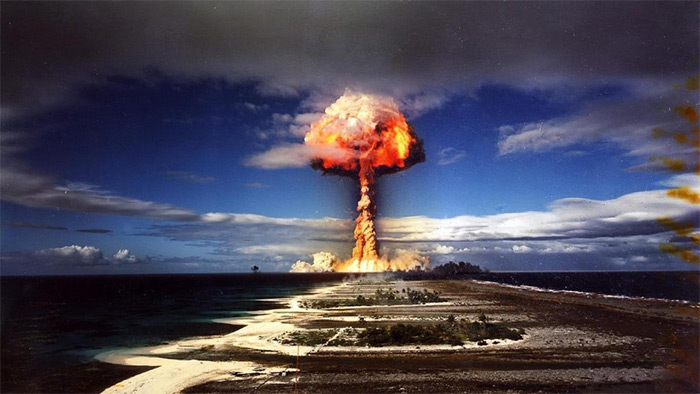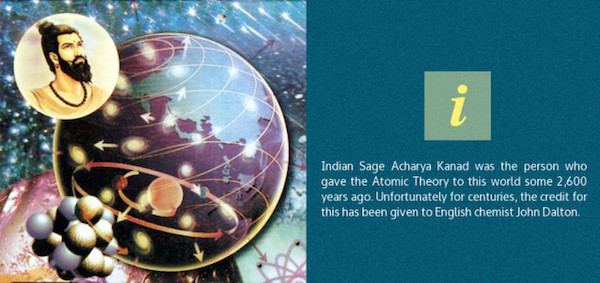
An English physicist, John Dalton, is often mistakingly credited with developing atomic theory, according to conventional scientific literature.
However, the true originator who discovered the atom was actually an ancient Indian sage who lived 2,600 years ago.

BYPASS THE CENSORS
Sign up to get unfiltered news delivered straight to your inbox.
You can unsubscribe any time. By subscribing you agree to our Terms of Use
Latest Video
The Indian sage and philosopher was called Kashyap and was born in 600 BC near Dwarka. Kashyap is the real father of the Atomic theory.

Ancient-code.com reports:
People called him ‘Kanad’, as ‘Kan’ which in ancient Sanskrit means ‘the smallest particle’ after he was seen collecting grains from the street while on a pilgrimage to Prayag. He was fascinated by the small particles and started collecting them. When asked why he was collecting them he answered that while individual grains might appear as useless or worthless to some, a collection of hundreds of grains could make persons daily meal, meaning that a collection of meals could feed a family and ultimately mankind.
He was fascinated with the world around it and started writing down his views on the world and eventually conceptualized the idea of ‘the smallest particle’ that makes up everything we see and don’t see. He passed on his knowledge to others, and people started calling him ‘Acharya’, which means the teacher. Thus, he was eventually called Acharya Kanad or ‘the teacher of small particles’.
“Every object of creation is made of atoms which in turn connect with each other to form molecules,” –Kanad.
The more we read about Kanad, the more fascinated we are with his life and work. The story behind how he conceptualized the idea of a particle that could not be divided any further is extremely interesting. One day, he was walking with food in his hand, and started breaking it into smaller and smaller pieces up to a moment when he realized he could not break down the food any further since it was too small, that’s when Kanad described ‘invisible matter as Paramnu or Anu which means ‘atom’.
According to Kanad, invisible matter cannot be sensed through any human organ, nor can it be seen by the naked eye. Kanad stated that an inherent urge made one Anu (atom) combine with another. Kanad further explained that when two Anu which belonged to the same ‘class’ of substance were combined, a dwinuka or binary molecule was created. The Ancient Indian Saga theorized that different mixtures of Anu produced very different types of substances.
It was Kanad who also put forward the idea that anu (atoms) could be combined in several different ways which would produce chemical changes in the presence of other factors like heat. To provide a more simplified explanation, Kanad gave blackening of earthen pot and ripening of fruit as an example.
Kanad was the founder of the Vaisheshika School of philosophy, the place where he shared his ideas, knowledge and taught his theories and about the atoms, the nature of the universe and everything that surrounds us, both visible and invisible. “Vaisheshik Darshan” was a book written by Kanad where he presented all of his research.
In regards to Kanad, his ideas, theories and discoveries, A.L. Basham, a veteran Australian Indologist stated that his teachings “were brilliant imaginative explanations of the physical structure of the world, and in a large measure, agreed with the discoveries of modern physics.”
However, Kanad was the only source of advanced knowledge from ancient India. According to statements by one of the most prominent Indian scientists, some ‘slokas’ aka verses of the holy Vedas texts make mention several, undiscovered natural phenomena that were discovered by Westerners many centuries later. Madhavan Nair stressed that the Vedas, or also known as the four sacred texts of one of the oldest missing Vedic religion, described the presence of water on the moon, the gravitational force, and other scientific phenomena there were not supposed to be known of until centuries later.
The Vedas contain an incredible wealth of information in the field of space and atomic energy, so much information that we are unaware of it even today. We were on the right track until the year 600 BC, before the invasions said the 71-year-old Padma Vibhushan awardee who believes the Vedas are a knowledge goldmine, with information on metallurgy, algebra, astronomy, math, architecture and astrology among other things.
According to the former boss of the Indian space agency, the Chandrayaan 1 satellite, which dropped on the lunar surface, the vehicle with the proud colors of India orbited around the moon thanks to an equation formulated thousands of years ago by Aryabhata.


